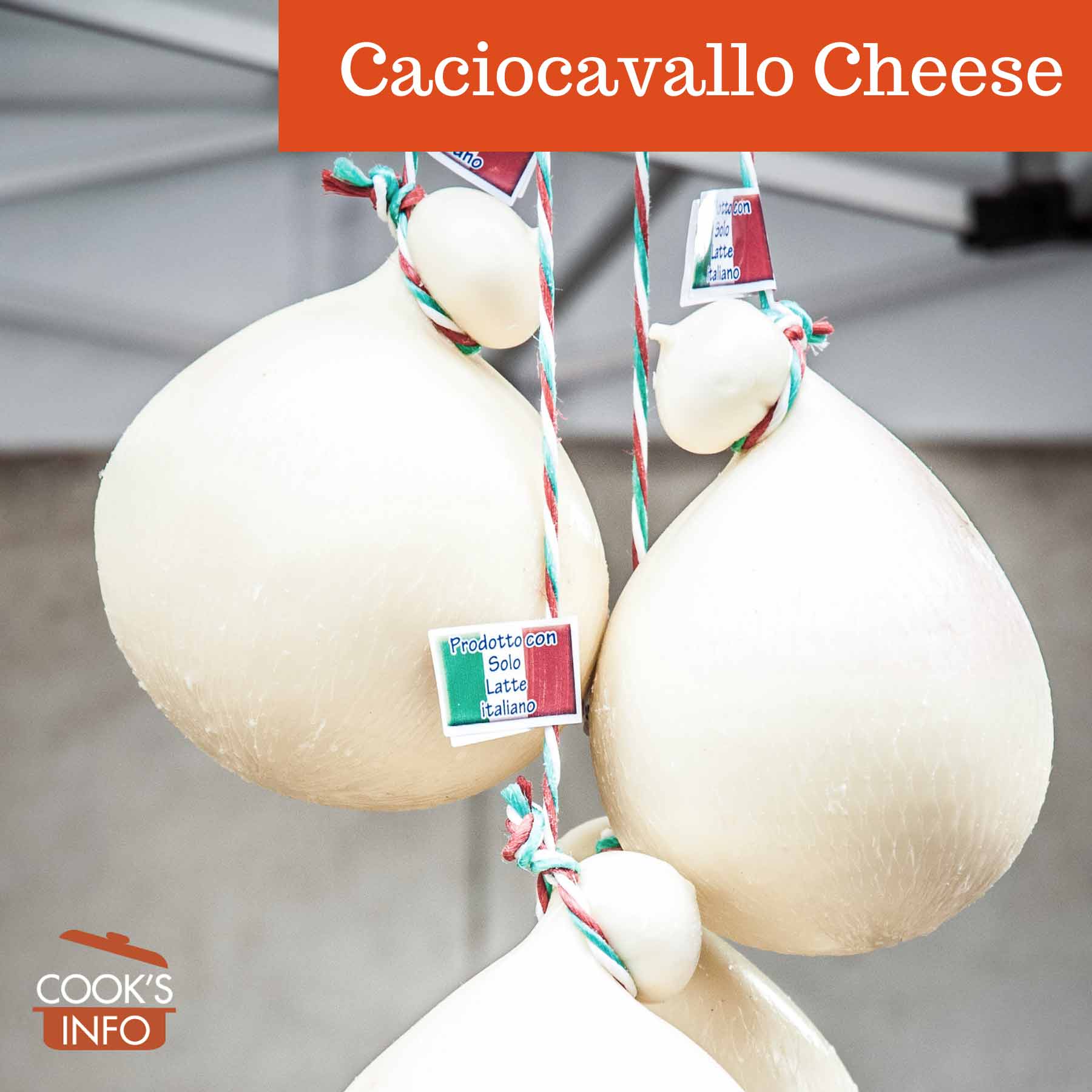
Caciocavallo cheese hanging in a store. As3d / Getty Images via Canva Pro.
Caciocavallo cheese is shaped like a small gourd, pear or flask, usually with a definite small ball on top, forming a defined neck between it and the larger body.
The process of making it is similar to that for mozzarella cheese. To make it, unpasteurized cow’s milk is heated to 36 to 38 C (97 to 100 F), and coagulated with calf’s rennet. The curd is then cut into walnut-sized pieces. The curd is then let stand for four to ten hours, depending upon the acidity of the milk, the weather, etc., until it gets to the stage that it can be pulled apart in strings.
The cheese strings are then wound or spun into a ball, while pressing on the growing ball so that there are no cavities inside and so that the outside remains smooth. Each completed cheese is then plunged into boiling water to seal the outside, then put into cold water to lower the temperature back down.
The cheese is then cured in brine for a period varying from six hours to a few days. A string is then tied around its neck, and it is hung over poles to age. The absolute minimum aging time is 2 weeks, but it is usually much longer.
Sicilian versions can be oval or cone shaped, depending on the custom in the locality where it was made. Instead of being cured in brine, Sicilian versions are salted.
At two months, caciocavallo cheese is still considered “young.” It is a stringy, semi-hard cheese with a mild flavour.
After that, the cheese develops a sharper flavour, and becomes hard enough to grate.
The cheeses will have grooves in their necks left by the cord.
The cheese is given different names, depending on the shape it was made in:
- Montonino – pear-shaped;
- Napolitano – spindle-shaped;
- Provolone or Melonessa – round
- Provetta – small, round.
Sometimes the cheese can be smoked as well; the smoked version is described as being “affumicato.”
Older ones and smoked ones may have darker rinds.
Caciocavallo cheese is mostly made in the south of Italy, in areas such as Molise, Campania and Sicily.
The version called “Caciocavallo Silano” received European PDO status in 1996. It can be made in designated parts of Basilicata, Calabria, Campania, Molise and Puglia. The milk used can come from, at most, four milkings in the two days prior to making the cheese. The cheese must be aged at least 30 days.

Aged / smoked caciocavallo cheese. ChiccoDodiFC / Getty Images via Canva Pro
History Notes
At some point in the past, it appears that Buffalo Milk was used.
Literature & Lore
“In the Kingdoms of Naples and Sicily they make a sort of cheese which they call Caseo di cavallo, i. e. Horse-cheese, for what reason I could not learn. These cheeses they make up in several forms; some in the fashion of a blown bladder, some in the fashion of a cylinder and some in other figures. They are neither fat nor strong, yet well-tasted and acceptable to such as have eaten of them awhile. The pulp or body of them lies in flakes and hath as it were a grain one way like wood. They told us that they were made of Buffles milk, but we believed them not, because we observed not many Buffles in those Countries, where there is more of this cheese made than of other sorts.” — John Ray (1627 – 1704/5), Observations Topographical, Moral, & Physiological. London, Printed for J. Martyn, 1673.
Language Notes
The name “caciocavallo” literally means “cheese on horseback”. Some theories about the name link it to a similar Turkish cheese called “qusqawal.” However, it’s likely vaguely related to its being hung over poles or rods, like a saddle over a horse, or related to its having a small knob on a larger round like a rider on a horse.
Some think the name might mean the cheese was made at some point from horse’s milk, but most experts consider this highly unlikely.
Sometimes erroneously spelt “cacciocavallo” (the error is the double c).
Sources
Caciocavallo Silano. Retrieved June 2009 from http://www.formaggio.it/italiaDOP/caciocavallosilano.htm .
Commission Regulation (EC) No 1204/2003. Amending the specifications of three names appearing in the Annex to Regulation (EC) No 1107/96 (Roncal, Noix de Grenoble and Caciocavallo Silano) 4 July 2003.

Interior of Caciocavallo cheese. © Cooksinfo / 2018

